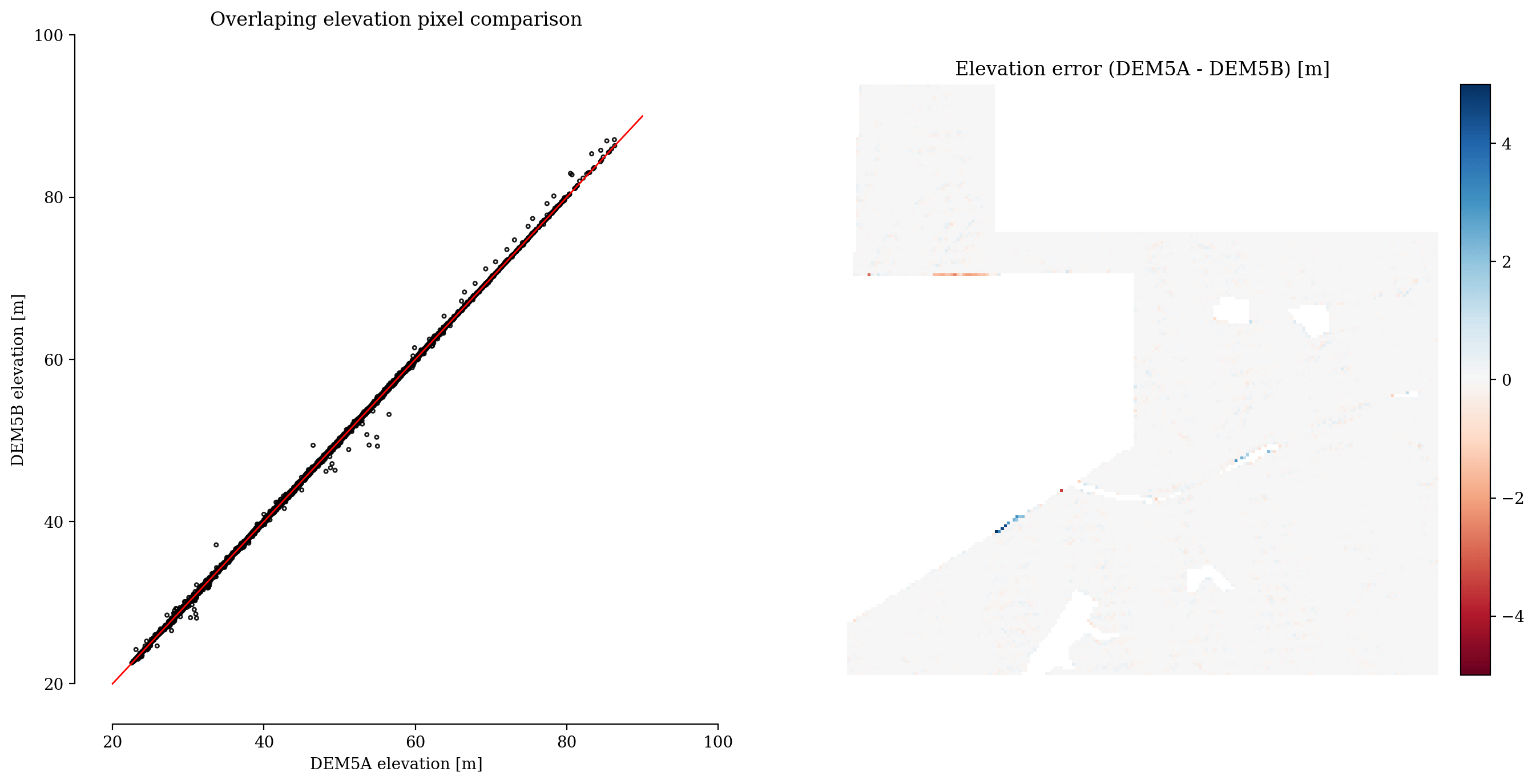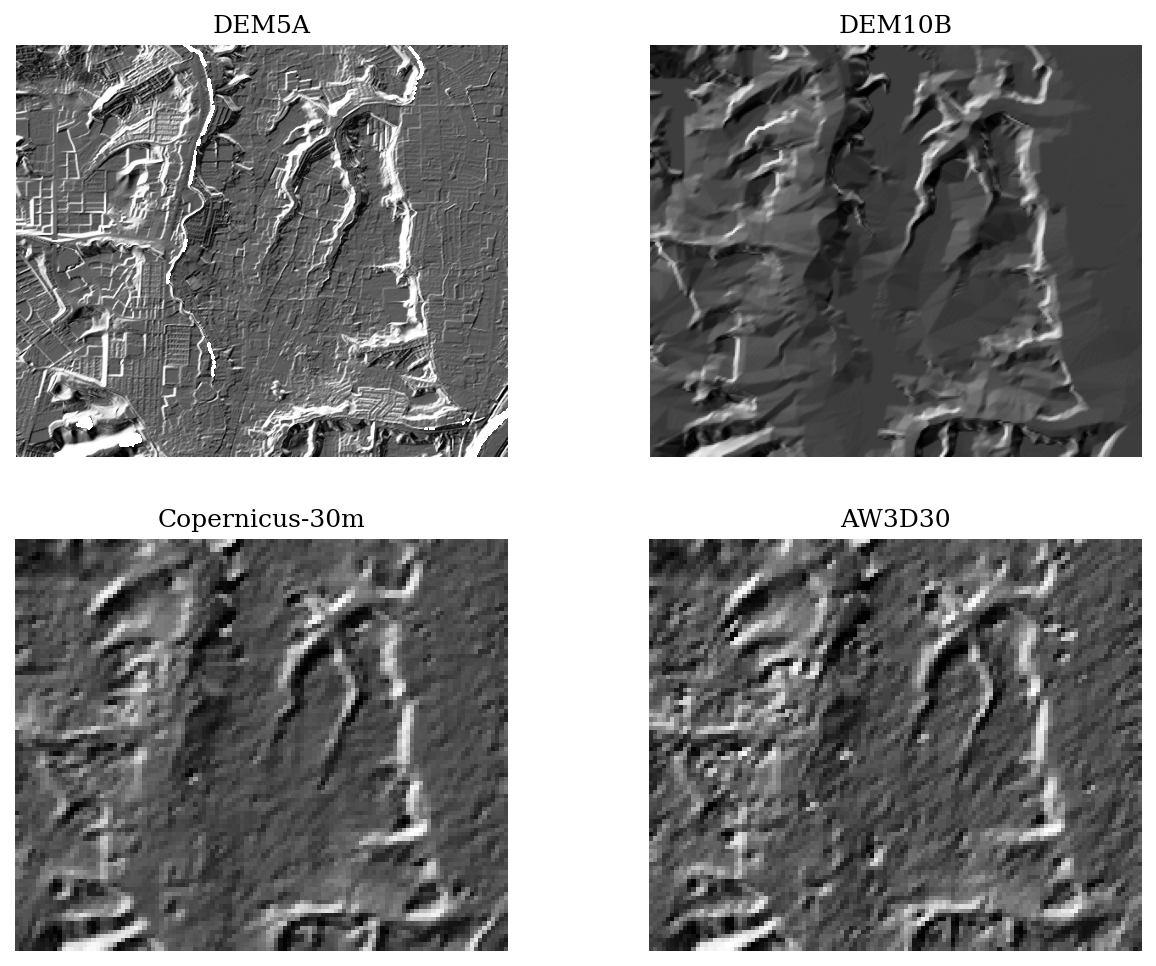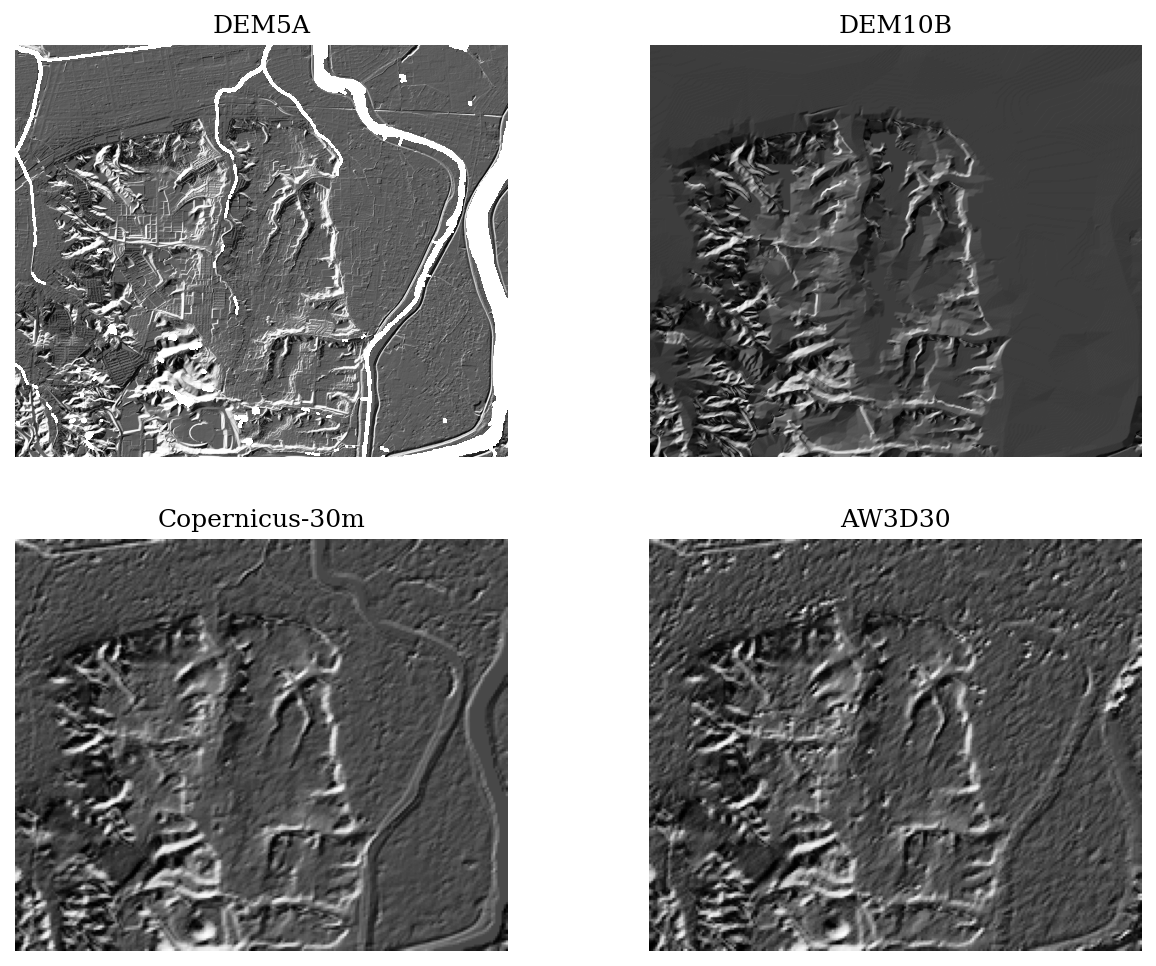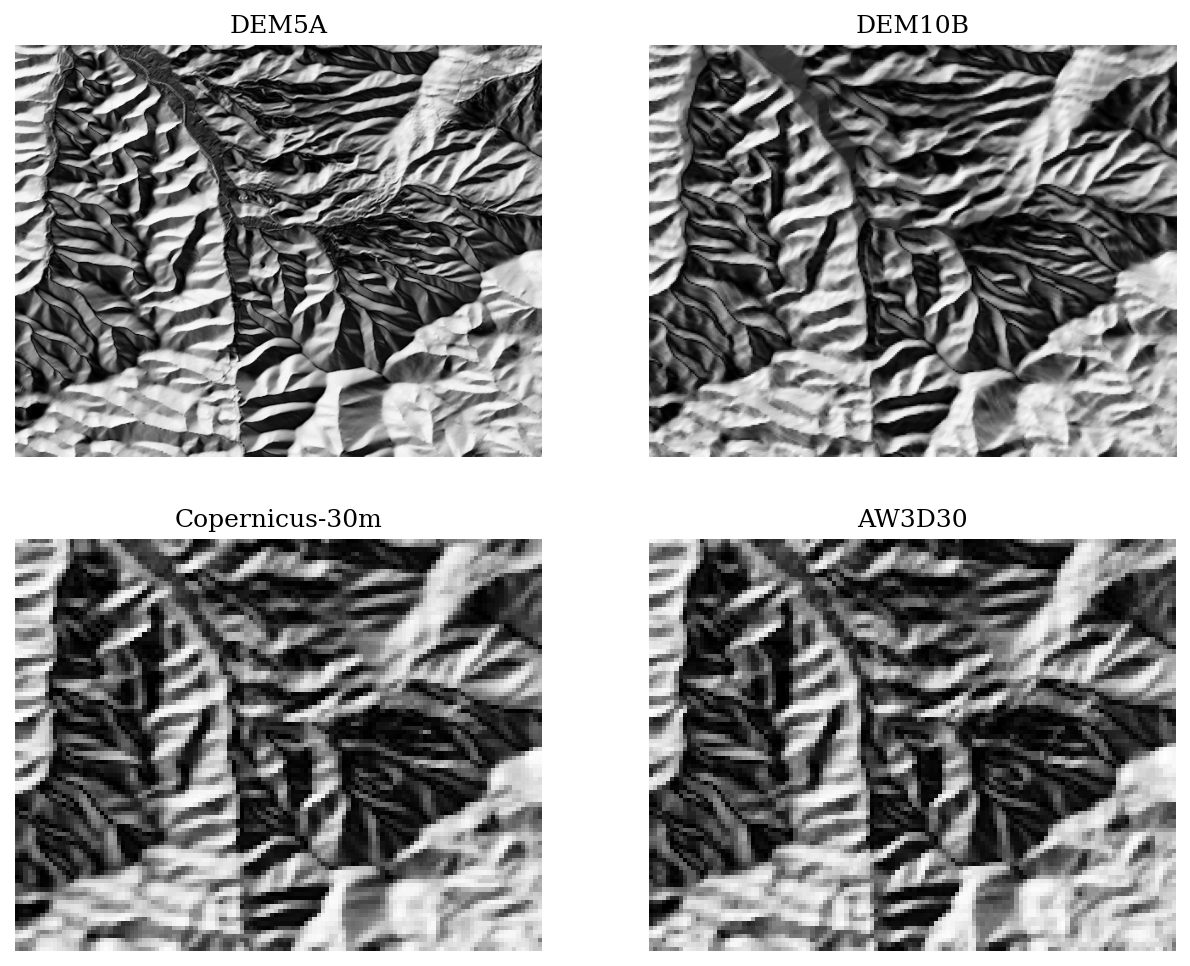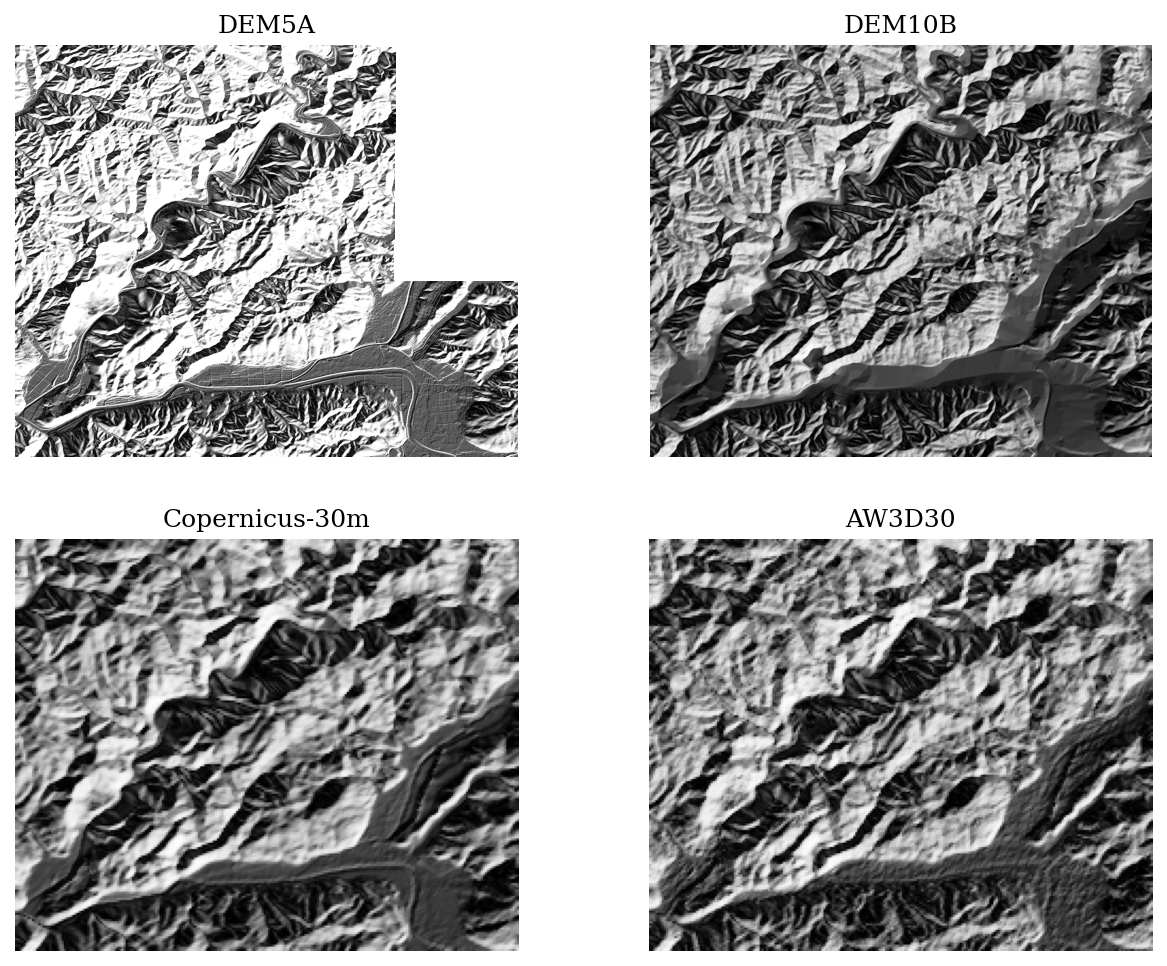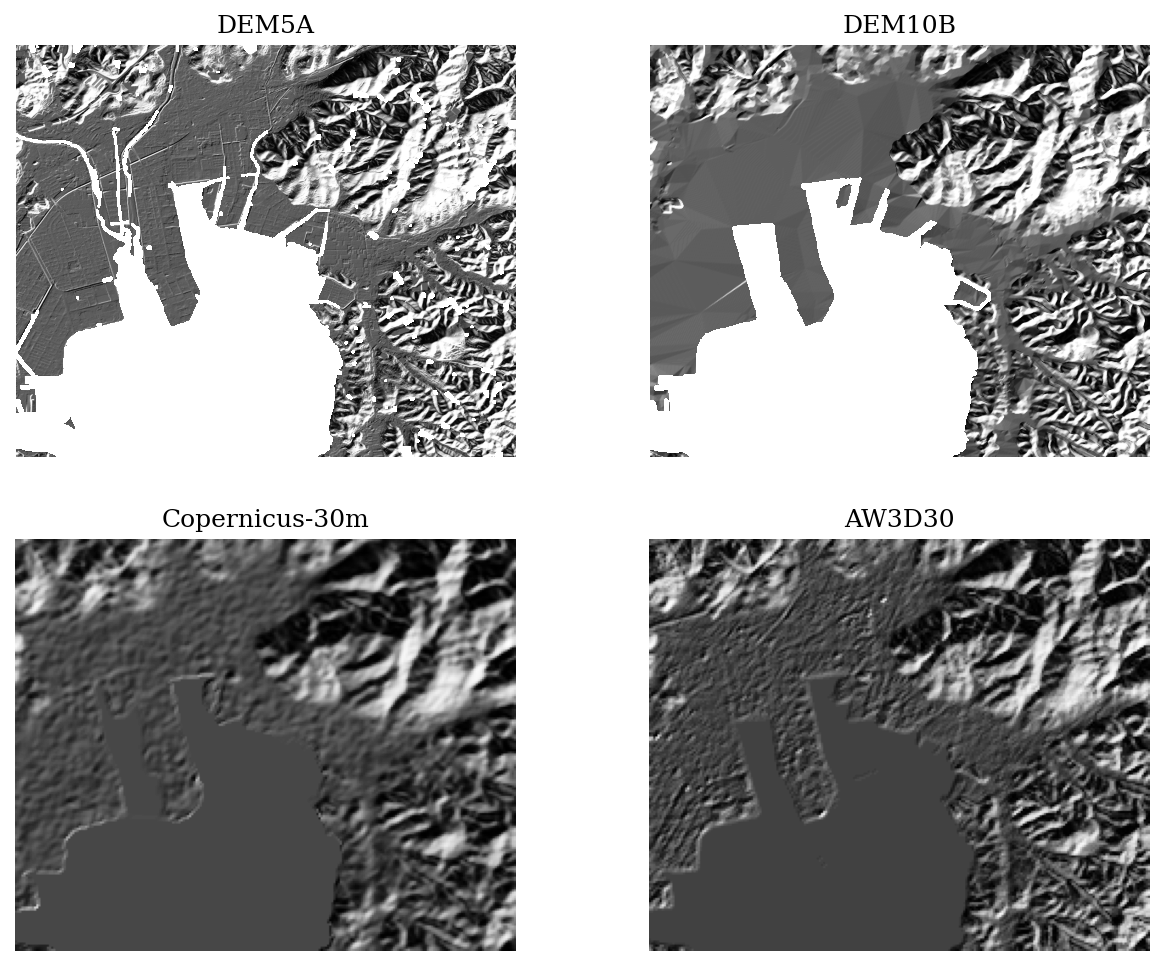Japan elevation data guide
There’s high resolution data available for Japan at 5m and 10m resolution. While the datasets are difficult to download, they are of high quality and worthwhile using if you need the resolution.
The 5m dataset captures more detail, but contains holes particularly around rivers and lakes, so for hydrological applications you’re better off with the more complete 10m dataset.
If high resolution isn’t needed, the 30m Copernicus dataset is high quality and easy to work with.
High-resolution datasets
Japan’s Geospatial Information Authority maintains open DEMs for Japan at 5m and 10m resolutions. There are multiple datasets at each resolution with varying coverage and quality.
| Approx. resolution |
Dataset | Collection method |
Area | 1σ vertical accuracy |
|---|---|---|---|---|
| 5 m | DEM5A | Lidar | 354,558 km2 | 0.3 m |
| DEM5B | Satellite | 60,869 km2 | 0.7 m | |
| DEM5C | Satellite | 25,156 km2 | 1.4 m | |
| 10 m | DEM10A | Map contours | 3,424 km2 | 2.5 m |
| DEM10B | Map contours | 483,261 km2 | 5 m |
Coverage
At a national level, the 5m DEM5A dataset covers about 70% of the country, though most urban and coastal regions are covered. The 10m DEM10B dataset spans the entire country, including outlying islands.
The 10m coverage isn’t perfect though: there are a few small gaps so if you need data guaranteed for the whole country you’ll need a fallback DEM.
As well as being patchy at a national level, DEM5A omits “inland waterways” larger than 10m which includes lakes and rivers. If you’re looking for hydrological data you’ll absolutely need to merge with a complimentary dataset!
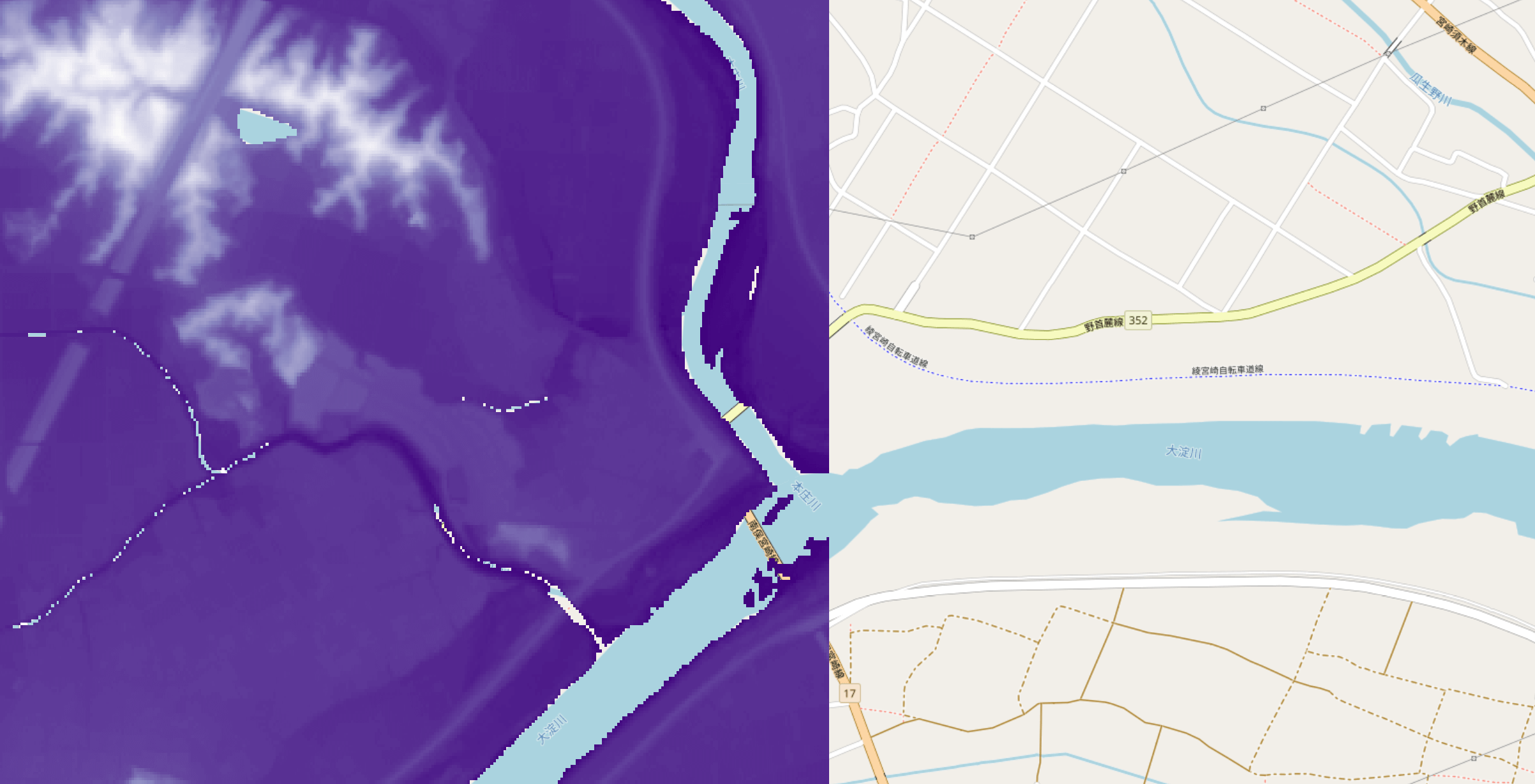
Can you just stack the datasets with the same resolution?
Stacking all the 5m datasets together would be an easy way to increase coverage: however there are slight differences where datasets of the same resolution overlap.
For example, here’s an elevation heatmap for DEM5A and DEM5B for the 5030-14 tile:
The merged raster isn’t bad, but there are some are some artefacts around the peak on the left. A pixel-to-pixel comparison over overlapping areas reveals that while the DEMs are similar (the mean error for this tile is 4cm), there are some pixels that vary more significantly.
So whether stacking the datasets is a good idea depends on your usecase: it’s probably fine for basic visualisation, but for something like hydrological modelling you’ll want to carefully coregister the DEMs like I have done for the GPXZ dataset.
To keep this analysis simple I’m just going to look at the datasets with the biggest coverage: that’s DEM5A and DEM10B.
Tiles from the same dataset can be merged without artefacts.
Low-resolution datasets
There are also global 30m datasets with coverage of Japan. While lower in resolution, they are smaller so easier to work with, and worth considering depending on your usecase. As of 2021, the 30m DEMs from Copernicus and AW3D30 the highest quality open global elevation datasets.
30m Copernicus can be downloaded from AWS.
Here's the Copernicus tiles to cover Japan (click to expand)
Copernicus_DSM_COG_10_N31_00_E130_00_DEM/Copernicus_DSM_COG_10_N31_00_E130_00_DEM.tif
Copernicus_DSM_COG_10_N31_00_E131_00_DEM/Copernicus_DSM_COG_10_N31_00_E131_00_DEM.tif
Copernicus_DSM_COG_10_N31_00_E139_00_DEM/Copernicus_DSM_COG_10_N31_00_E139_00_DEM.tif
Copernicus_DSM_COG_10_N31_00_E140_00_DEM/Copernicus_DSM_COG_10_N31_00_E140_00_DEM.tif
Copernicus_DSM_COG_10_N32_00_E130_00_DEM/Copernicus_DSM_COG_10_N32_00_E130_00_DEM.tif
Copernicus_DSM_COG_10_N32_00_E131_00_DEM/Copernicus_DSM_COG_10_N32_00_E131_00_DEM.tif
Copernicus_DSM_COG_10_N32_00_E132_00_DEM/Copernicus_DSM_COG_10_N32_00_E132_00_DEM.tif
Copernicus_DSM_COG_10_N32_00_E133_00_DEM/Copernicus_DSM_COG_10_N32_00_E133_00_DEM.tif
Copernicus_DSM_COG_10_N32_00_E139_00_DEM/Copernicus_DSM_COG_10_N32_00_E139_00_DEM.tif
Copernicus_DSM_COG_10_N33_00_E130_00_DEM/Copernicus_DSM_COG_10_N33_00_E130_00_DEM.tif
Copernicus_DSM_COG_10_N33_00_E131_00_DEM/Copernicus_DSM_COG_10_N33_00_E131_00_DEM.tif
Copernicus_DSM_COG_10_N33_00_E132_00_DEM/Copernicus_DSM_COG_10_N33_00_E132_00_DEM.tif
Copernicus_DSM_COG_10_N33_00_E133_00_DEM/Copernicus_DSM_COG_10_N33_00_E133_00_DEM.tif
Copernicus_DSM_COG_10_N33_00_E134_00_DEM/Copernicus_DSM_COG_10_N33_00_E134_00_DEM.tif
Copernicus_DSM_COG_10_N33_00_E135_00_DEM/Copernicus_DSM_COG_10_N33_00_E135_00_DEM.tif
Copernicus_DSM_COG_10_N33_00_E136_00_DEM/Copernicus_DSM_COG_10_N33_00_E136_00_DEM.tif
Copernicus_DSM_COG_10_N33_00_E138_00_DEM/Copernicus_DSM_COG_10_N33_00_E138_00_DEM.tif
Copernicus_DSM_COG_10_N33_00_E139_00_DEM/Copernicus_DSM_COG_10_N33_00_E139_00_DEM.tif
Copernicus_DSM_COG_10_N34_00_E130_00_DEM/Copernicus_DSM_COG_10_N34_00_E130_00_DEM.tif
Copernicus_DSM_COG_10_N34_00_E131_00_DEM/Copernicus_DSM_COG_10_N34_00_E131_00_DEM.tif
Copernicus_DSM_COG_10_N34_00_E132_00_DEM/Copernicus_DSM_COG_10_N34_00_E132_00_DEM.tif
Copernicus_DSM_COG_10_N34_00_E133_00_DEM/Copernicus_DSM_COG_10_N34_00_E133_00_DEM.tif
Copernicus_DSM_COG_10_N34_00_E134_00_DEM/Copernicus_DSM_COG_10_N34_00_E134_00_DEM.tif
Copernicus_DSM_COG_10_N34_00_E135_00_DEM/Copernicus_DSM_COG_10_N34_00_E135_00_DEM.tif
Copernicus_DSM_COG_10_N34_00_E136_00_DEM/Copernicus_DSM_COG_10_N34_00_E136_00_DEM.tif
Copernicus_DSM_COG_10_N34_00_E137_00_DEM/Copernicus_DSM_COG_10_N34_00_E137_00_DEM.tif
Copernicus_DSM_COG_10_N34_00_E138_00_DEM/Copernicus_DSM_COG_10_N34_00_E138_00_DEM.tif
Copernicus_DSM_COG_10_N34_00_E139_00_DEM/Copernicus_DSM_COG_10_N34_00_E139_00_DEM.tif
Copernicus_DSM_COG_10_N35_00_E132_00_DEM/Copernicus_DSM_COG_10_N35_00_E132_00_DEM.tif
Copernicus_DSM_COG_10_N35_00_E133_00_DEM/Copernicus_DSM_COG_10_N35_00_E133_00_DEM.tif
Copernicus_DSM_COG_10_N35_00_E134_00_DEM/Copernicus_DSM_COG_10_N35_00_E134_00_DEM.tif
Copernicus_DSM_COG_10_N35_00_E135_00_DEM/Copernicus_DSM_COG_10_N35_00_E135_00_DEM.tif
Copernicus_DSM_COG_10_N35_00_E136_00_DEM/Copernicus_DSM_COG_10_N35_00_E136_00_DEM.tif
Copernicus_DSM_COG_10_N35_00_E137_00_DEM/Copernicus_DSM_COG_10_N35_00_E137_00_DEM.tif
Copernicus_DSM_COG_10_N35_00_E138_00_DEM/Copernicus_DSM_COG_10_N35_00_E138_00_DEM.tif
Copernicus_DSM_COG_10_N35_00_E139_00_DEM/Copernicus_DSM_COG_10_N35_00_E139_00_DEM.tif
Copernicus_DSM_COG_10_N35_00_E140_00_DEM/Copernicus_DSM_COG_10_N35_00_E140_00_DEM.tif
Copernicus_DSM_COG_10_N36_00_E132_00_DEM/Copernicus_DSM_COG_10_N36_00_E132_00_DEM.tif
Copernicus_DSM_COG_10_N36_00_E133_00_DEM/Copernicus_DSM_COG_10_N36_00_E133_00_DEM.tif
Copernicus_DSM_COG_10_N36_00_E135_00_DEM/Copernicus_DSM_COG_10_N36_00_E135_00_DEM.tif
Copernicus_DSM_COG_10_N36_00_E136_00_DEM/Copernicus_DSM_COG_10_N36_00_E136_00_DEM.tif
Copernicus_DSM_COG_10_N36_00_E137_00_DEM/Copernicus_DSM_COG_10_N36_00_E137_00_DEM.tif
Copernicus_DSM_COG_10_N36_00_E138_00_DEM/Copernicus_DSM_COG_10_N36_00_E138_00_DEM.tif
Copernicus_DSM_COG_10_N36_00_E139_00_DEM/Copernicus_DSM_COG_10_N36_00_E139_00_DEM.tif
Copernicus_DSM_COG_10_N36_00_E140_00_DEM/Copernicus_DSM_COG_10_N36_00_E140_00_DEM.tif
Copernicus_DSM_COG_10_N37_00_E130_00_DEM/Copernicus_DSM_COG_10_N37_00_E130_00_DEM.tif
Copernicus_DSM_COG_10_N37_00_E131_00_DEM/Copernicus_DSM_COG_10_N37_00_E131_00_DEM.tif
Copernicus_DSM_COG_10_N37_00_E136_00_DEM/Copernicus_DSM_COG_10_N37_00_E136_00_DEM.tif
Copernicus_DSM_COG_10_N37_00_E137_00_DEM/Copernicus_DSM_COG_10_N37_00_E137_00_DEM.tif
Copernicus_DSM_COG_10_N37_00_E138_00_DEM/Copernicus_DSM_COG_10_N37_00_E138_00_DEM.tif
Copernicus_DSM_COG_10_N37_00_E139_00_DEM/Copernicus_DSM_COG_10_N37_00_E139_00_DEM.tif
Copernicus_DSM_COG_10_N37_00_E140_00_DEM/Copernicus_DSM_COG_10_N37_00_E140_00_DEM.tif
Copernicus_DSM_COG_10_N37_00_E141_00_DEM/Copernicus_DSM_COG_10_N37_00_E141_00_DEM.tif
Copernicus_DSM_COG_10_N38_00_E138_00_DEM/Copernicus_DSM_COG_10_N38_00_E138_00_DEM.tif
Copernicus_DSM_COG_10_N38_00_E139_00_DEM/Copernicus_DSM_COG_10_N38_00_E139_00_DEM.tif
Copernicus_DSM_COG_10_N38_00_E140_00_DEM/Copernicus_DSM_COG_10_N38_00_E140_00_DEM.tif
Copernicus_DSM_COG_10_N38_00_E141_00_DEM/Copernicus_DSM_COG_10_N38_00_E141_00_DEM.tif
Copernicus_DSM_COG_10_N39_00_E139_00_DEM/Copernicus_DSM_COG_10_N39_00_E139_00_DEM.tif
Copernicus_DSM_COG_10_N39_00_E140_00_DEM/Copernicus_DSM_COG_10_N39_00_E140_00_DEM.tif
Copernicus_DSM_COG_10_N39_00_E141_00_DEM/Copernicus_DSM_COG_10_N39_00_E141_00_DEM.tif
Copernicus_DSM_COG_10_N39_00_E142_00_DEM/Copernicus_DSM_COG_10_N39_00_E142_00_DEM.tif
Copernicus_DSM_COG_10_N40_00_E139_00_DEM/Copernicus_DSM_COG_10_N40_00_E139_00_DEM.tif
Copernicus_DSM_COG_10_N40_00_E140_00_DEM/Copernicus_DSM_COG_10_N40_00_E140_00_DEM.tif
Copernicus_DSM_COG_10_N40_00_E141_00_DEM/Copernicus_DSM_COG_10_N40_00_E141_00_DEM.tif
Copernicus_DSM_COG_10_N41_00_E130_00_DEM/Copernicus_DSM_COG_10_N41_00_E130_00_DEM.tif
Copernicus_DSM_COG_10_N41_00_E139_00_DEM/Copernicus_DSM_COG_10_N41_00_E139_00_DEM.tif
Copernicus_DSM_COG_10_N41_00_E140_00_DEM/Copernicus_DSM_COG_10_N41_00_E140_00_DEM.tif
Copernicus_DSM_COG_10_N41_00_E141_00_DEM/Copernicus_DSM_COG_10_N41_00_E141_00_DEM.tif
Copernicus_DSM_COG_10_N41_00_E143_00_DEM/Copernicus_DSM_COG_10_N41_00_E143_00_DEM.tif
Copernicus_DSM_COG_10_N42_00_E130_00_DEM/Copernicus_DSM_COG_10_N42_00_E130_00_DEM.tif
Copernicus_DSM_COG_10_N42_00_E131_00_DEM/Copernicus_DSM_COG_10_N42_00_E131_00_DEM.tif
Copernicus_DSM_COG_10_N42_00_E132_00_DEM/Copernicus_DSM_COG_10_N42_00_E132_00_DEM.tif
Copernicus_DSM_COG_10_N42_00_E133_00_DEM/Copernicus_DSM_COG_10_N42_00_E133_00_DEM.tif
Copernicus_DSM_COG_10_N42_00_E134_00_DEM/Copernicus_DSM_COG_10_N42_00_E134_00_DEM.tif
Copernicus_DSM_COG_10_N42_00_E139_00_DEM/Copernicus_DSM_COG_10_N42_00_E139_00_DEM.tif
Copernicus_DSM_COG_10_N42_00_E140_00_DEM/Copernicus_DSM_COG_10_N42_00_E140_00_DEM.tif
Copernicus_DSM_COG_10_N42_00_E141_00_DEM/Copernicus_DSM_COG_10_N42_00_E141_00_DEM.tif
Copernicus_DSM_COG_10_N42_00_E142_00_DEM/Copernicus_DSM_COG_10_N42_00_E142_00_DEM.tif
Copernicus_DSM_COG_10_N42_00_E143_00_DEM/Copernicus_DSM_COG_10_N42_00_E143_00_DEM.tif
Copernicus_DSM_COG_10_N42_00_E144_00_DEM/Copernicus_DSM_COG_10_N42_00_E144_00_DEM.tif
Copernicus_DSM_COG_10_N42_00_E145_00_DEM/Copernicus_DSM_COG_10_N42_00_E145_00_DEM.tif
Copernicus_DSM_COG_10_N43_00_E130_00_DEM/Copernicus_DSM_COG_10_N43_00_E130_00_DEM.tif
Copernicus_DSM_COG_10_N43_00_E131_00_DEM/Copernicus_DSM_COG_10_N43_00_E131_00_DEM.tif
Copernicus_DSM_COG_10_N43_00_E132_00_DEM/Copernicus_DSM_COG_10_N43_00_E132_00_DEM.tif
Copernicus_DSM_COG_10_N43_00_E133_00_DEM/Copernicus_DSM_COG_10_N43_00_E133_00_DEM.tif
Copernicus_DSM_COG_10_N43_00_E134_00_DEM/Copernicus_DSM_COG_10_N43_00_E134_00_DEM.tif
Copernicus_DSM_COG_10_N43_00_E135_00_DEM/Copernicus_DSM_COG_10_N43_00_E135_00_DEM.tif
Copernicus_DSM_COG_10_N43_00_E140_00_DEM/Copernicus_DSM_COG_10_N43_00_E140_00_DEM.tif
Copernicus_DSM_COG_10_N43_00_E141_00_DEM/Copernicus_DSM_COG_10_N43_00_E141_00_DEM.tif
Copernicus_DSM_COG_10_N43_00_E142_00_DEM/Copernicus_DSM_COG_10_N43_00_E142_00_DEM.tif
Copernicus_DSM_COG_10_N43_00_E143_00_DEM/Copernicus_DSM_COG_10_N43_00_E143_00_DEM.tif
Copernicus_DSM_COG_10_N43_00_E144_00_DEM/Copernicus_DSM_COG_10_N43_00_E144_00_DEM.tif
Copernicus_DSM_COG_10_N43_00_E145_00_DEM/Copernicus_DSM_COG_10_N43_00_E145_00_DEM.tif
Copernicus_DSM_COG_10_N43_00_E146_00_DEM/Copernicus_DSM_COG_10_N43_00_E146_00_DEM.tif
Copernicus_DSM_COG_10_N44_00_E130_00_DEM/Copernicus_DSM_COG_10_N44_00_E130_00_DEM.tif
Copernicus_DSM_COG_10_N44_00_E131_00_DEM/Copernicus_DSM_COG_10_N44_00_E131_00_DEM.tif
Copernicus_DSM_COG_10_N44_00_E132_00_DEM/Copernicus_DSM_COG_10_N44_00_E132_00_DEM.tif
Copernicus_DSM_COG_10_N44_00_E133_00_DEM/Copernicus_DSM_COG_10_N44_00_E133_00_DEM.tif
Copernicus_DSM_COG_10_N44_00_E134_00_DEM/Copernicus_DSM_COG_10_N44_00_E134_00_DEM.tif
Copernicus_DSM_COG_10_N44_00_E135_00_DEM/Copernicus_DSM_COG_10_N44_00_E135_00_DEM.tif
Copernicus_DSM_COG_10_N44_00_E136_00_DEM/Copernicus_DSM_COG_10_N44_00_E136_00_DEM.tif
Copernicus_DSM_COG_10_N44_00_E141_00_DEM/Copernicus_DSM_COG_10_N44_00_E141_00_DEM.tif
Copernicus_DSM_COG_10_N44_00_E142_00_DEM/Copernicus_DSM_COG_10_N44_00_E142_00_DEM.tif
Copernicus_DSM_COG_10_N44_00_E143_00_DEM/Copernicus_DSM_COG_10_N44_00_E143_00_DEM.tif
Copernicus_DSM_COG_10_N44_00_E144_00_DEM/Copernicus_DSM_COG_10_N44_00_E144_00_DEM.tif
Copernicus_DSM_COG_10_N44_00_E145_00_DEM/Copernicus_DSM_COG_10_N44_00_E145_00_DEM.tif
Copernicus_DSM_COG_10_N44_00_E146_00_DEM/Copernicus_DSM_COG_10_N44_00_E146_00_DEM.tif
Copernicus_DSM_COG_10_N45_00_E130_00_DEM/Copernicus_DSM_COG_10_N45_00_E130_00_DEM.tif
Copernicus_DSM_COG_10_N45_00_E131_00_DEM/Copernicus_DSM_COG_10_N45_00_E131_00_DEM.tif
Copernicus_DSM_COG_10_N45_00_E132_00_DEM/Copernicus_DSM_COG_10_N45_00_E132_00_DEM.tif
Copernicus_DSM_COG_10_N45_00_E133_00_DEM/Copernicus_DSM_COG_10_N45_00_E133_00_DEM.tif
Copernicus_DSM_COG_10_N45_00_E134_00_DEM/Copernicus_DSM_COG_10_N45_00_E134_00_DEM.tif
Copernicus_DSM_COG_10_N45_00_E135_00_DEM/Copernicus_DSM_COG_10_N45_00_E135_00_DEM.tif
Copernicus_DSM_COG_10_N45_00_E136_00_DEM/Copernicus_DSM_COG_10_N45_00_E136_00_DEM.tif
Copernicus_DSM_COG_10_N45_00_E137_00_DEM/Copernicus_DSM_COG_10_N45_00_E137_00_DEM.tif
Copernicus_DSM_COG_10_N45_00_E140_00_DEM/Copernicus_DSM_COG_10_N45_00_E140_00_DEM.tif
Copernicus_DSM_COG_10_N45_00_E141_00_DEM/Copernicus_DSM_COG_10_N45_00_E141_00_DEM.tif
Copernicus_DSM_COG_10_N45_00_E142_00_DEM/Copernicus_DSM_COG_10_N45_00_E142_00_DEM.tif
The 30m AW3D30 dataset can be downloaded from JAXA.
Here's the AW3D30 tiles to needed cover Japan (click to expand)
N030E130/N031E130/ALPSMLC30_N031E130_DSM.tif
N030E130/N031E131/ALPSMLC30_N031E131_DSM.tif
N030E130/N032E130/ALPSMLC30_N032E130_DSM.tif
N030E130/N032E131/ALPSMLC30_N032E131_DSM.tif
N030E130/N032E132/ALPSMLC30_N032E132_DSM.tif
N030E130/N032E133/ALPSMLC30_N032E133_DSM.tif
N030E130/N033E130/ALPSMLC30_N033E130_DSM.tif
N030E130/N033E131/ALPSMLC30_N033E131_DSM.tif
N030E130/N033E132/ALPSMLC30_N033E132_DSM.tif
N030E130/N033E133/ALPSMLC30_N033E133_DSM.tif
N030E130/N033E134/ALPSMLC30_N033E134_DSM.tif
N030E130/N034E130/ALPSMLC30_N034E130_DSM.tif
N030E130/N034E131/ALPSMLC30_N034E131_DSM.tif
N030E130/N034E132/ALPSMLC30_N034E132_DSM.tif
N030E130/N034E133/ALPSMLC30_N034E133_DSM.tif
N030E130/N034E134/ALPSMLC30_N034E134_DSM.tif
N030E135/N031E139/ALPSMLC30_N031E139_DSM.tif
N030E135/N032E139/ALPSMLC30_N032E139_DSM.tif
N030E135/N033E135/ALPSMLC30_N033E135_DSM.tif
N030E135/N033E136/ALPSMLC30_N033E136_DSM.tif
N030E135/N033E138/ALPSMLC30_N033E138_DSM.tif
N030E135/N033E139/ALPSMLC30_N033E139_DSM.tif
N030E135/N034E135/ALPSMLC30_N034E135_DSM.tif
N030E135/N034E136/ALPSMLC30_N034E136_DSM.tif
N030E135/N034E137/ALPSMLC30_N034E137_DSM.tif
N030E135/N034E138/ALPSMLC30_N034E138_DSM.tif
N030E135/N034E139/ALPSMLC30_N034E139_DSM.tif
N030E140/N031E140/ALPSMLC30_N031E140_DSM.tif
N035E130/N035E132/ALPSMLC30_N035E132_DSM.tif
N035E130/N035E133/ALPSMLC30_N035E133_DSM.tif
N035E130/N035E134/ALPSMLC30_N035E134_DSM.tif
N035E130/N036E132/ALPSMLC30_N036E132_DSM.tif
N035E130/N036E133/ALPSMLC30_N036E133_DSM.tif
N035E130/N037E130/ALPSMLC30_N037E130_DSM.tif
N035E130/N037E131/ALPSMLC30_N037E131_DSM.tif
N035E135/N035E135/ALPSMLC30_N035E135_DSM.tif
N035E135/N035E136/ALPSMLC30_N035E136_DSM.tif
N035E135/N035E137/ALPSMLC30_N035E137_DSM.tif
N035E135/N035E138/ALPSMLC30_N035E138_DSM.tif
N035E135/N035E139/ALPSMLC30_N035E139_DSM.tif
N035E135/N036E135/ALPSMLC30_N036E135_DSM.tif
N035E135/N036E136/ALPSMLC30_N036E136_DSM.tif
N035E135/N036E137/ALPSMLC30_N036E137_DSM.tif
N035E135/N036E138/ALPSMLC30_N036E138_DSM.tif
N035E135/N036E139/ALPSMLC30_N036E139_DSM.tif
N035E135/N037E136/ALPSMLC30_N037E136_DSM.tif
N035E135/N037E137/ALPSMLC30_N037E137_DSM.tif
N035E135/N037E138/ALPSMLC30_N037E138_DSM.tif
N035E135/N037E139/ALPSMLC30_N037E139_DSM.tif
N035E135/N038E138/ALPSMLC30_N038E138_DSM.tif
N035E135/N038E139/ALPSMLC30_N038E139_DSM.tif
N035E135/N039E139/ALPSMLC30_N039E139_DSM.tif
N035E140/N035E140/ALPSMLC30_N035E140_DSM.tif
N035E140/N036E140/ALPSMLC30_N036E140_DSM.tif
N035E140/N037E140/ALPSMLC30_N037E140_DSM.tif
N035E140/N037E141/ALPSMLC30_N037E141_DSM.tif
N035E140/N038E140/ALPSMLC30_N038E140_DSM.tif
N035E140/N038E141/ALPSMLC30_N038E141_DSM.tif
N035E140/N039E140/ALPSMLC30_N039E140_DSM.tif
N035E140/N039E141/ALPSMLC30_N039E141_DSM.tif
N035E140/N039E142/ALPSMLC30_N039E142_DSM.tif
N040E130/N041E130/ALPSMLC30_N041E130_DSM.tif
N040E130/N042E130/ALPSMLC30_N042E130_DSM.tif
N040E130/N042E131/ALPSMLC30_N042E131_DSM.tif
N040E130/N042E132/ALPSMLC30_N042E132_DSM.tif
N040E130/N042E133/ALPSMLC30_N042E133_DSM.tif
N040E130/N042E134/ALPSMLC30_N042E134_DSM.tif
N040E130/N043E130/ALPSMLC30_N043E130_DSM.tif
N040E130/N043E131/ALPSMLC30_N043E131_DSM.tif
N040E130/N043E132/ALPSMLC30_N043E132_DSM.tif
N040E130/N043E133/ALPSMLC30_N043E133_DSM.tif
N040E130/N043E134/ALPSMLC30_N043E134_DSM.tif
N040E130/N044E130/ALPSMLC30_N044E130_DSM.tif
N040E130/N044E131/ALPSMLC30_N044E131_DSM.tif
N040E130/N044E132/ALPSMLC30_N044E132_DSM.tif
N040E130/N044E133/ALPSMLC30_N044E133_DSM.tif
N040E130/N044E134/ALPSMLC30_N044E134_DSM.tif
N040E135/N040E139/ALPSMLC30_N040E139_DSM.tif
N040E135/N041E139/ALPSMLC30_N041E139_DSM.tif
N040E135/N042E139/ALPSMLC30_N042E139_DSM.tif
N040E135/N043E135/ALPSMLC30_N043E135_DSM.tif
N040E135/N044E135/ALPSMLC30_N044E135_DSM.tif
N040E135/N044E136/ALPSMLC30_N044E136_DSM.tif
N040E140/N040E140/ALPSMLC30_N040E140_DSM.tif
N040E140/N040E141/ALPSMLC30_N040E141_DSM.tif
N040E140/N041E140/ALPSMLC30_N041E140_DSM.tif
N040E140/N041E141/ALPSMLC30_N041E141_DSM.tif
N040E140/N041E143/ALPSMLC30_N041E143_DSM.tif
N040E140/N042E140/ALPSMLC30_N042E140_DSM.tif
N040E140/N042E141/ALPSMLC30_N042E141_DSM.tif
N040E140/N042E142/ALPSMLC30_N042E142_DSM.tif
N040E140/N042E143/ALPSMLC30_N042E143_DSM.tif
N040E140/N042E144/ALPSMLC30_N042E144_DSM.tif
N040E140/N043E140/ALPSMLC30_N043E140_DSM.tif
N040E140/N043E141/ALPSMLC30_N043E141_DSM.tif
N040E140/N043E142/ALPSMLC30_N043E142_DSM.tif
N040E140/N043E143/ALPSMLC30_N043E143_DSM.tif
N040E140/N043E144/ALPSMLC30_N043E144_DSM.tif
N040E140/N044E141/ALPSMLC30_N044E141_DSM.tif
N040E140/N044E142/ALPSMLC30_N044E142_DSM.tif
N040E140/N044E143/ALPSMLC30_N044E143_DSM.tif
N040E140/N044E144/ALPSMLC30_N044E144_DSM.tif
N040E145/N042E145/ALPSMLC30_N042E145_DSM.tif
N040E145/N043E145/ALPSMLC30_N043E145_DSM.tif
N040E145/N043E146/ALPSMLC30_N043E146_DSM.tif
N040E145/N044E145/ALPSMLC30_N044E145_DSM.tif
N040E145/N044E146/ALPSMLC30_N044E146_DSM.tif
N045E130/N045E130/ALPSMLC30_N045E130_DSM.tif
N045E130/N045E131/ALPSMLC30_N045E131_DSM.tif
N045E130/N045E132/ALPSMLC30_N045E132_DSM.tif
N045E130/N045E133/ALPSMLC30_N045E133_DSM.tif
N045E130/N045E134/ALPSMLC30_N045E134_DSM.tif
N045E135/N045E135/ALPSMLC30_N045E135_DSM.tif
N045E135/N045E136/ALPSMLC30_N045E136_DSM.tif
N045E135/N045E137/ALPSMLC30_N045E137_DSM.tif
N045E140/N045E140/ALPSMLC30_N045E140_DSM.tif
N045E140/N045E141/ALPSMLC30_N045E141_DSM.tif
N045E140/N045E142/ALPSMLC30_N045E142_DSM.tif
Detail
As expected, the 5m DEM5A lidar dataset captures a good amount of detail.
The 10m DEM10B dataset captures significantly less detail especially in flat areas due to being derived from map contours. It still offers better detail than the 30m dataset though, especially in mountainous areas.
Out of the 30m global datasets, Copernicus has a bit less noise than AW3D30. This matches what I’ve observed in other areas of the world, and is why I use Copernicus as the base layer for the GPXZ dataset.
Here’s some hillshaded images of different areas in Japan:
Coastlines
In the Japanese DEMs, sea/ocean is represented by NODATA and the coastal mask seems to be very accurate.
Both Copernicus and AW3D30 represent water by 0 elevation levels, which can be harder to extract as a mask. AW3D30 also comes with a water mask in a separate file for each tile that seems accurate given the 30m dataset resolution. The Copernicus tiles on AWS don’t include such a mask so it can be tricky to accurately remove water.
Elevation API
GPXZ is an API for high-quality global elevation data. If you need elevation data for Japan, check out our API documentation or reach out at [email protected]!
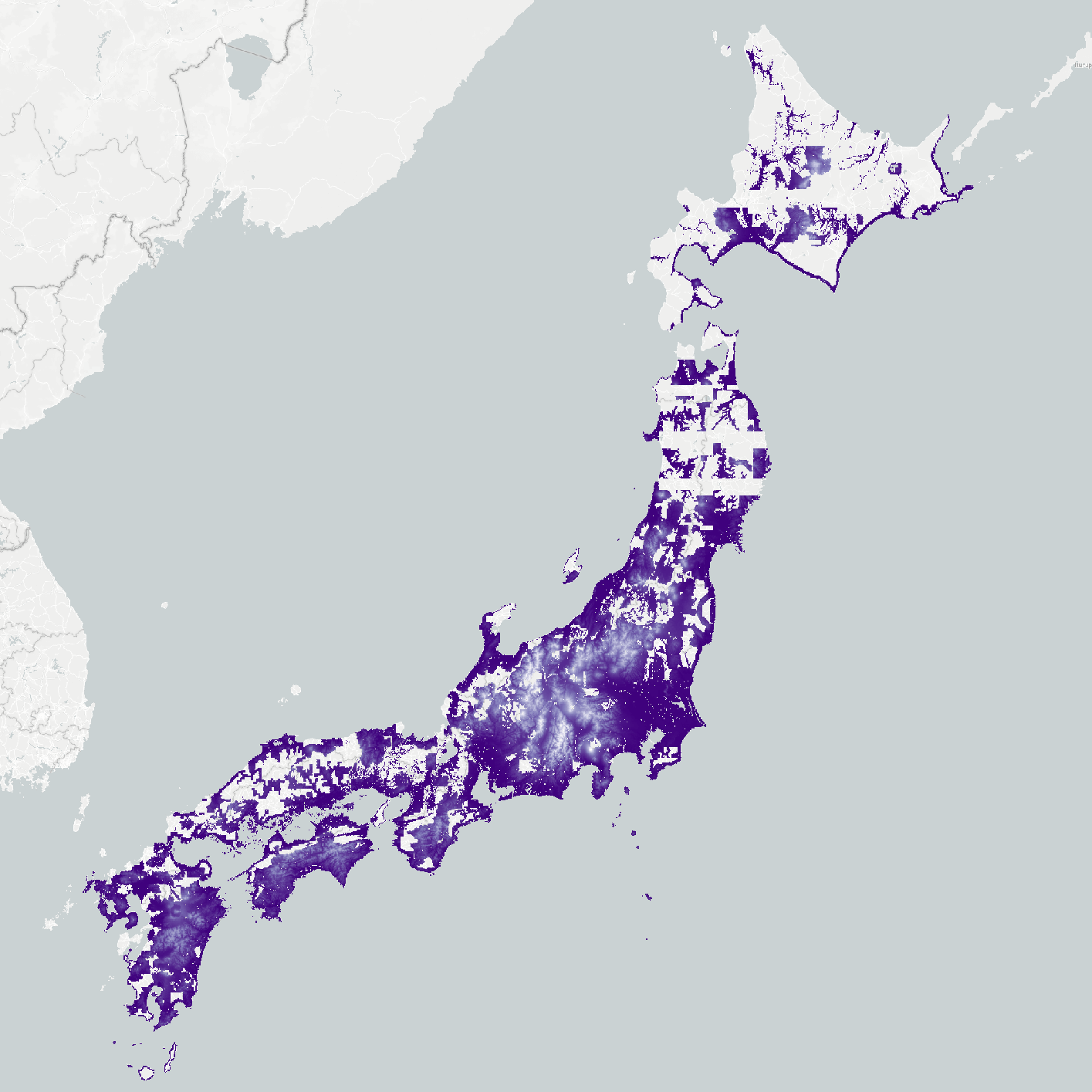 DEM5A coverage
DEM5A coverage
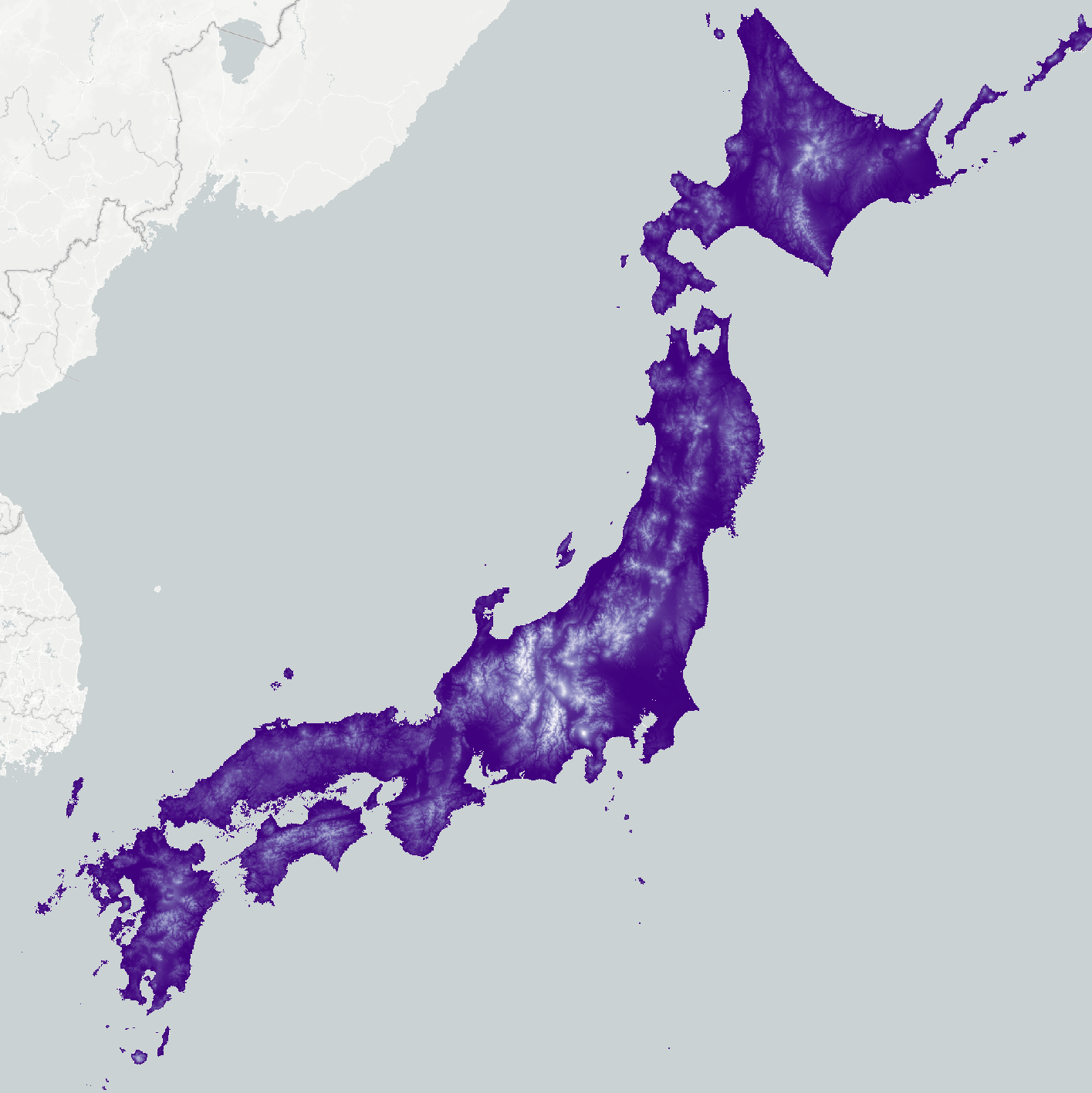 DEM10B coverage
DEM10B coverage

